
views
Locking the Bike Securely

Pop off the front wheel. If your bike has a quick-release front wheel, remove it and place it next to the rear wheel for locking. If you can't remove your front wheel, or your U lock is not large enough to encompass both wheels, secure the rear wheel then continue reading for alternatives.
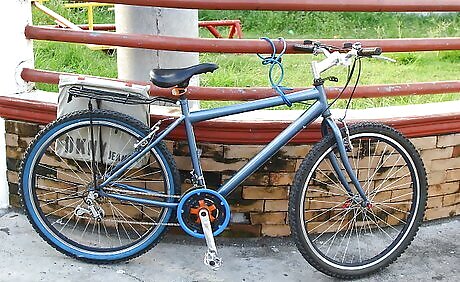
Secure the wheels and frame to an immovable object. Using a "D" or "U" lock, secure the back end of your bike to another object. Place the "U" section of your lock around the rim of your rear wheel, your unattached front wheel, your rear frame, and the immovable object, then attach the straight bar to ends of the "U" to lock it. See Using Decent Locks for advice on U locks, and Selecting a Lock Location for how to select an object to secure your bike to. If your U lock is too small to fit around every object, use it on just the rear wheel and stationary object but place it "inside" the triangle made by the three rear sections of the bike's frame. This makes it impossible to pull the frame away from the wheel. This is usually enough to deter a thief, since he would have to destroy the valuable rear wheel to take the bike. Do not attach your U-lock to the crossbar (or "top tube") of the bike. This is the horizontal or down-sloping bar between the seat and the handlebars. This makes it easy for thieves to use the bike frame as leverage to attempt to break the lock.
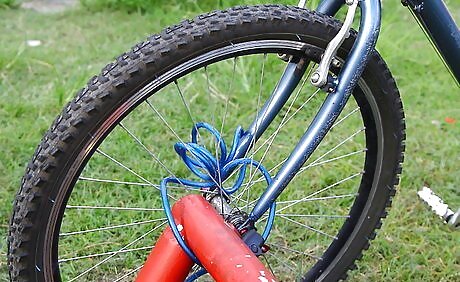
Secure the front wheel (if not removed). The front wheel is less valuable than the rear, but some level of security should still be used or even an opportunistic passerby could steal the wheel. You can loop a cable lock around the front wheel and the bike frame, and optionally around the rear wheel as well if the cable is long enough. Lock the cable together using its built in lock or a padlock. For greater security, use a second U-lock instead to secure the front wheel to its frame.
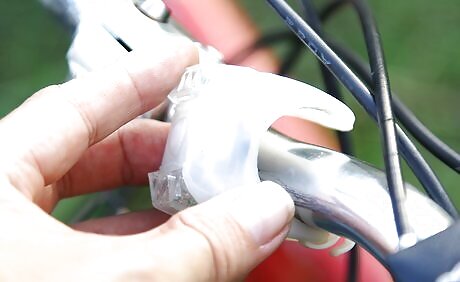
Remove or secure any accessories before leaving your bike. Bags, baskets, lights, reflectors, bells, and anything else that can be removed should be taken with you or secured with their own cable lock.
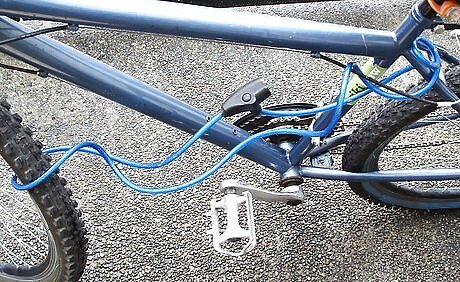
Secure the saddle with a long cable. Use a D lock on rear wheel, through frame and an immovable object. Secure the front wheel using one end of the cable by pushing it through. Push a loop of the cable through the rails of your saddle; secure by passing the free end of the cable through the loop. Secure the free end in the D lock.
Using Decent Locks
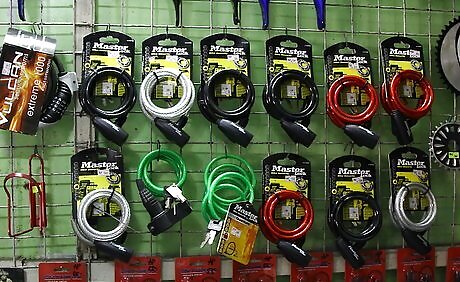
Invest in good locks. Cheap locks can easily be cut open, especially ones from 99p or dollar stores and some underground sports shops. (And thieves know the difference.) You can find better locks at a bike shop or a general sporting goods store.
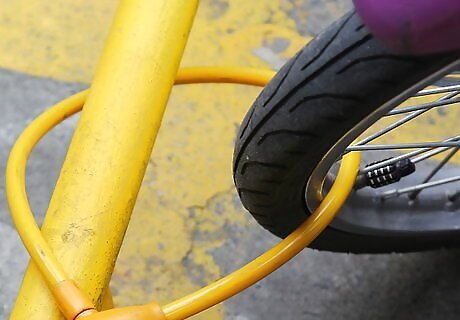
Use two or more different locks. Using at least two good quality locks of different types (listed below) will deter thieves that only have the tools to deal with one type, or who don't want to deal with the extra hassle.
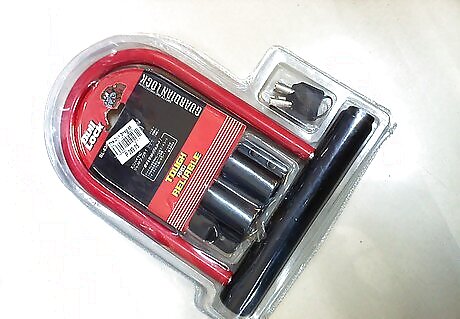
Select a small, hardened steel U-lock. Also called D-locks, these inflexible loops affix the frame and/or wheels to a solid object. The smaller the U-lock, the harder it will be for a thief to lever it open with a jack or other tool. For best security, pick a U-lock that is just barely large enough to fit over your rear wheel, frame, and the object you're locking the bike to. While the space inside the U lock should be as small as possible, the U lock material itself should be thick and strong.
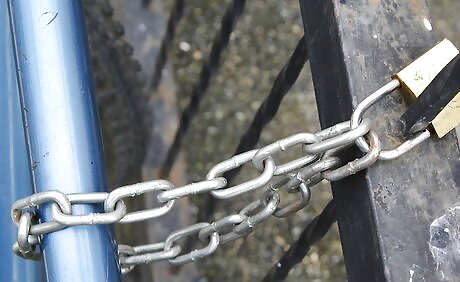
Consider heavy chains. Sufficiently thick chains (ideally 15mm links or more) are an excellent thief deterrent. On the other hand, they are much heavier than other options. Chains are usually secured by a padlock, which can be the weakest link. Use as thick a padlock as possible to resist bolt cutter attacks. A short chain for locking one wheel of your bike to an object will be much lighter to carry around than a chain long enough for both wheels. In this case, you will need an additional lock (which is a good practice to adopt anyway).

Use cable locks only as a supplement. You can purchase a thick (20mm) cable lock that is somewhat harder to cut, but the best course of action is to use cable locks as additional thief deterrent, not stand alone security. Cable locks can also be used to secure less valuable bike attachments to the frame, such as a basket.
Selecting a Lock Location

Know the neighborhood. When possible, avoid leaving your bike in areas with high incidents of bike theft. Your local bike shop or police department should know where the most bike theft occurs.
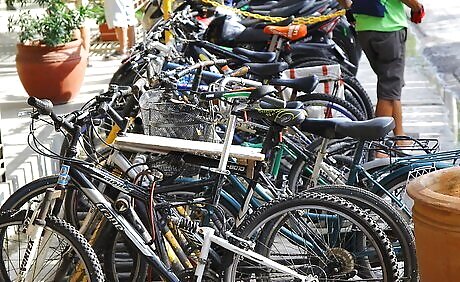
Try not to lock your bike in front of loiterers. People hanging around near a bike rack may be there to steal bikes or to tip off a bike thief as soon as you leave.

Don't use a train station or other commuter location. Thieves know where commuters typically leave their bikes unattended for a full workday, and will be more confident about spending a long time to steal a bike.
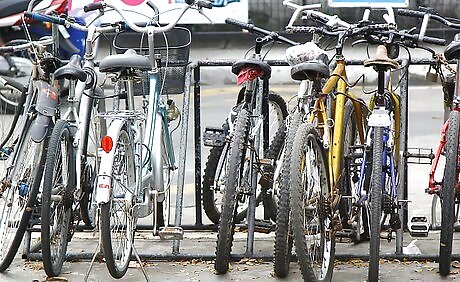
Select a well-lit area with plenty of foot traffic. The more pedestrians there are, and the easier they can see your bike, the harder it is for a thief to unobtrusively break your locks. If possible, place your bike in view of a nearby building's video surveillance camera. Even if this fails to deter a thief, you may be able to obtain footage of the theft to aid in recovery.

Find an immovable object for locking the bike. Don't assume that every bike rack is a safe option. Use an object with these attributes when locking your bike: Thick and sturdy. Don't select a wooden fence or thin steel object that can quickly be cut apart. Hard to disassemble. Check metal racks or railings for bolts; these can be removed by a dedicated thief. Firmly fastened to the ground. A strong thief or a team of thieves could simply pick up and remove a heavy object with the bike attached. Shake signposts to test whether they are anchored firmly to the pavement. Impossible to lift the bike over. A tall thief could simply lift your bike over the top of the object and take it home to remove the lock in private. Try to use something that is attached to the ground in two places, such as a sturdy bike rack, since a very dedicated thief could use a rope to hoist your bike even over a relatively tall object.
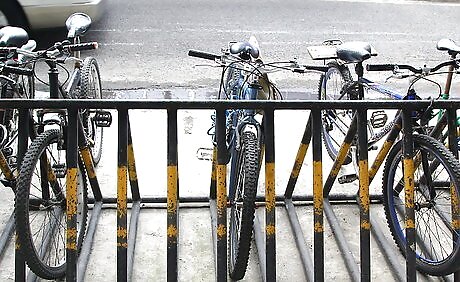
Lock your bike between other bikes when possible. The bikes at the end of a row of bikes are most visible to thieves but also the easiest for them to work on unobtrusively. Make sure you don't lock your bike to another bike with a careless cable lock.
Deterring Thieves and Preparing for Theft
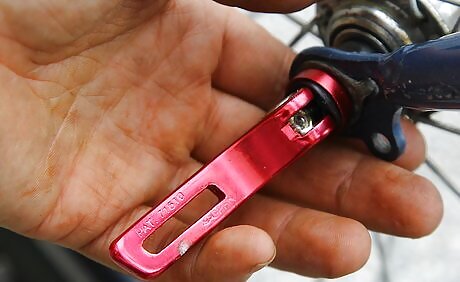
Replace your quick release skewers with more secure options. Many bikes have quick release wheels and saddles, which can be removed with a touch of the right tool. Many bike thieves are happy to walk away with just a seat and wheels, or with a bike missing a wheel if you didn't lock the frame. Locking skewers, available at bike stores or online, require a unique handle or key to remove (or at least additional effort by the thief). Simply remove the quick release skewers as normal and insert the more secure skewers in the same slot. Some cheaper skewers attach to the bike with a hex nut instead. These are still removed with a common tool (hex key or Allen key), but deter casual opportunists. Never leave the means to remove the skewer next to an unattended bike.
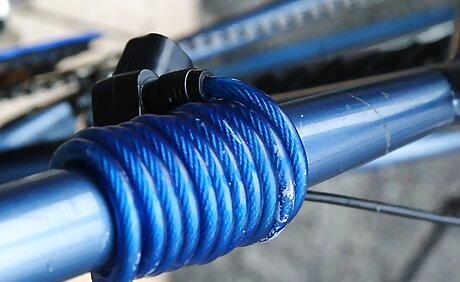
Secure your saddle in other ways. If you don't use locking skewers or desire additional security, you can use a length of chain to tie your seat to the frame: Wrap a long length of bicycle chain with electrical tape. This will prevent it from scratching your bike. Wrap the chain around the chain stays of the bike (the small bar of the frame parallel to the bike's chain). Then bring it up through the metal saddle rails that hold your saddle on the seat post. Secure the chain by clamping the chain together with pliers.
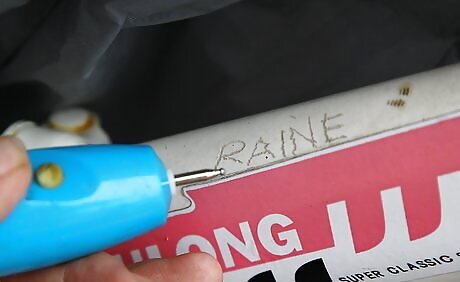
Write your name on the bike. It's harder to sell an easily identified bike. Use a marker to write your name or initials twice on each tire (on opposite points of the circumference), and/or onto the top of the frame. If writing your name on the frame, protect it with several layer of clear tape. This isn't too hard for a thief to remove, but every deterrent helps the thief move on to search for an easier target.
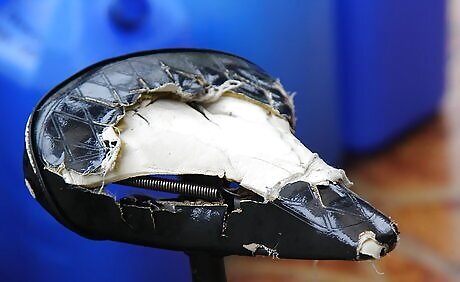
Make your bike less appealing. Before you enter a high-crime area, disguise your fancy new bike by wrapping easy to remove electrical tape around parts of the frame, seat, and handlebars. (This makes it look like you're repairing or hiding damage.) If you have a fancy, expensive bike seat, carry it inside instead of leaving it on the bike. You could also replace it with a secondhand seat when you're using your bike for commuting or routine errands.
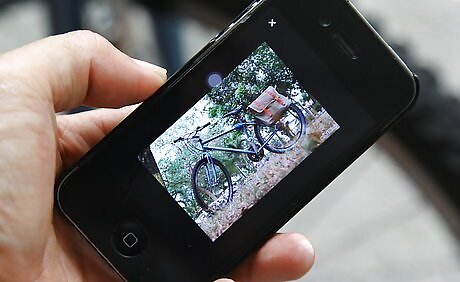
Keep proof of ownership. An easy way to accomplish this is to take a photograph of yourself at home next to your bike, holding a piece of paper with the bike's serial number written on it. Most serial numbers are located where the two pedal cranks meet. Other common locations include the headset (beneath the handlebars) and the rear stays (the bars parallel to the bike chain). Ask a friend or someone at your local bike shop for help if you cannot locate it.

Register your bike in a database. Register your bike for free with Bike Shepherd or a different database to obtain unique scanning stickers for your bike, send out theft alerts, and similar benefits
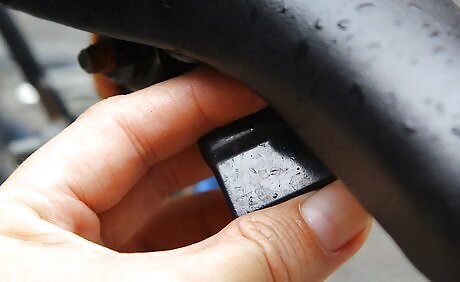
Attach a GPS tracker. For especially valuable or sentimental bikes, spend the extra money on a GPS tracker designed to attach securely to your bike. This will allow you or the police to track the bike's location in case of theft.
Recovering a Stolen Bike

File a police report as soon as possible. Have the bike's serial number ready to give them if you know it. You can do this online, but showing up in person at the nearest police station may lead to a faster response. Let the police know about your GPS tracker if one is attached to your bike.

List your bike as stolen in an online database. There are many websites that keep a local or global registry of stolen bikes. You can enter information about your theft on these for free.

Spread the word. Let your friends know that your bike is stolen, post about it on social media, and tell people who spend time near where it was stolen (such as the employees at the business you locked your bike in front of). The more people who know your bike was missing, the greater the chance someone will see it and tell you. Be sure to provide your contact information and a detailed description of your bicycle.
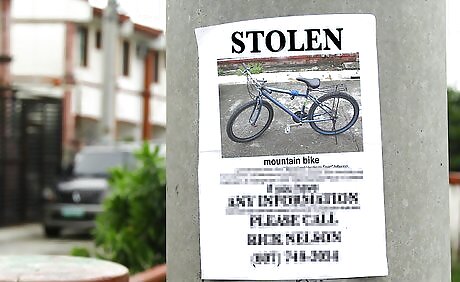
Post stolen bike notices on telephone poles and online. Craigslist and other online noticeboards often have sections for announcing stolen bikes. If you receive information, pass it on to police.

Ask for surveillance tapes, if available. Return to the spot your bike was stolen and look at nearby buildings for video cameras. If you see any, ask the owners if you or the police can review their tapes to help identify the bike thief.
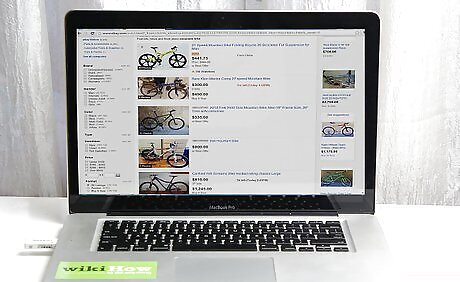
Keep an eye out for similar bikes sold online. eBay, Gumtree, and Craigslist are all common places for bike thieves to sell bikes. Check regularly for bikes of the model that was stolen for bikes that might be yours. If you find a likely candidate, notify the police and the website owners. The easiest way to do this is to set up an automatic alert on each site that will send you an email every time a bike of a certain model is put up for sale. The process varies for each website; search the FAQ or ask customer service about "automatic alerts", "auto-search", or "saved searches".

Visit local flea markets and other places secondhand bikes are sold. Find out where used bikes are commonly sold in your area and visit them. If you see your bike there, make sure it's yours and contact the police.
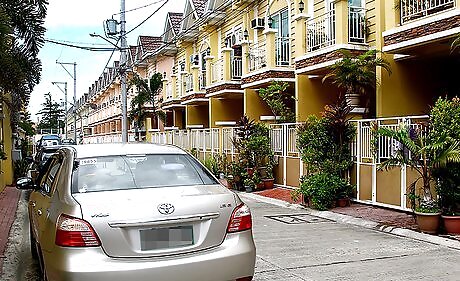
File a claim with your renter or homeowner insurance. Bicycle theft is covered under some plans, but you'll need to submit the claim within a certain time period following the theft. If you used a high-security lock, contact the manufacturers and see if they have an anti-theft guarantee.

Do not take risks to recover the bike yourself. Once you've located your bike, let the police recover it rather than risking injury to do so yourself.




















Comments
0 comment